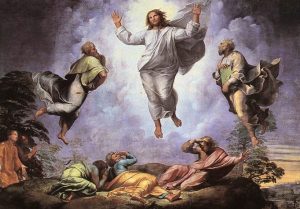2nd Sunday of Lent – Cycle B (Mk 9:2-10)

Rafael – The Transfiguration
Transfiguration is not an easy word to grasp. Outside of the Bible the only recent use that I can recall is in the Harry Potter books by J.K. Rowling, where the young wizards attend a “Transfiguration” class. But the class really isn’t about transfiguration but rather transformation which is defined as changing from one thing into another; such as from a human into a dog or a cat. Jesus was not transformed, he was transfigured and in this case, transfiguration is seeing reality, seeing Jesus for who he really is, the Son of God. Jesus does not change form; he remains himself, it is only his divinity that is revealed.
Transfiguration is defined as a marked change in form or appearance; a metamorphosis. In school, long ago, I remember being taught that you cannot define a word using the word itself. For example, you cannot define “transfiguration as the act of being transfigured.” That makes perfect sense to me. But I believe that you should also never use equally obscure, equally unknown words within a definition, words such as metamorphosis. The definition of metamorphosis is a change of physical form, structure, or substance especially by supernatural means. And supernatural is defined as departing from what is usual or normal especially so as to appear to transcend the laws of nature. So, if we really think about it, transfiguration simply means to change one’s physical appearance in some unknown or abnormal way.
At the beginning of his masterpiece The Lord of the Rings J.R.R. Tolkien introduces one of his main characters, the wizard Gandalf the Grey. Later, after battling the Balrog for many days, Gandalf dies, only to be reborn, to be transfigured as Gandalf the White.
Mark does not describe the transfiguration of Jesus other than to say “He was transfigured before them and his clothes became dazzling white…” We can only imagine to what extent his physical appearance was changed.
We are reminded at various times throughout the bible that no one can look upon the face of God and live. God is often described as a light so bright as to overwhelm our human senses. This causes us to pause and try to find some means of comprehending, of imagining the glory of God. Like the three blind men who are confronted with an elephant, a thing that they have never experienced, we grope blindly in order to come to conclusions beyond reason or fact.
How many of us have stood on the shores of a lake, such as our own beautiful Lake Tahoe, or a great sea or an ocean, watching the waves, admiring the beauty and vastness of the waters, and observed how wonderful a sight it was to behold. Yet, beneath the surface is a world, far more beautiful, more wondrous, more enchanting than one could ever imagine.
As a scuba diver, I have had the opportunity to dive in many places around the world, and yet I am always amazed at the hidden treasures that lie just beneath the surface, the abundance and variety of sea life, the vivid colors, the quiet stillness, the ever changing dynamics of a world unknown and unseen by those who have never looked below the surface. I believe that, in a small way, when we consider the hidden beauty that surrounds us, we can begin to understand the awesome power, the glory, and the beauty that is God.
St. Ephraim, a 4th century Syrian was an ordained deacon in Mesopotamia (now Turkey.) He was a doctor of the Church and was renowned as the lyre—or harp—of the Holy Spirit. He explained the Transfiguration of Jesus quite clearly and with great understanding. He taught that to discover why Jesus was transfigured we must first see Jesus through the eyes of his apostles; to the apostles, Jesus was just a man, the son of Mary and Joseph. They saw Jesus as a normal human being, eating and drinking, working and sweating, growing tired and falling asleep. They did not know, they had no idea that Jesus was God.
In order for the apostles to comprehend his true nature Jesus took them up the mountain and was transfigured before their eyes. They heard the voice of God; they saw and believed that Jesus was truly divine, that he was truly the Son of God.
But why did Jesus feel it necessary to reveal his divinity? St. Ephraim further explains that He revealed his divinity, his mighty power, his divine glory to prepare the apostles for what was yet to come, to help them understand the true nature of his impending passion, death, and resurrection. Jesus revealed his divine nature so that the apostles, as well as ourselves, could understand that it was not for any lack of power on his part that he allowed himself to be crucified by his enemies, but rather because he had freely chosen to suffer in that way for our salvation.
Looking out across the sea, above the surface, we cannot hope to grasp the richness of what lies beneath the waves. We are blind to the fullness of life that exists beyond our senses. Jesus was transfigured before his friends so that they could, and we can, if only for a moment, see beyond the surface, to see the beauty of his reality, to know that he was more than just a man, to know that he is God.
